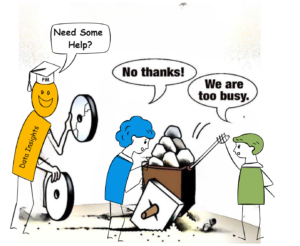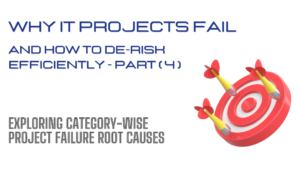Why do IT Projects fail - and How to de-risk them efficiently - (Part 4)
Project failures – Major Root causes
Linking back:
In the previous article in this series, we talked about “Major Root cause categories for Project Failures“.
This was an attempt to identify highest-impact potential drivers of Project failures.
In this post, I shall go into some specific Root causes, and how they may impact Projects.
I shall be grouping the Root causes on the basis of Root cause categories.
Root causes vs Project Types
For the various Project types defined previously (Exploratory, Greenfield, Build/Operate/Transfer, COTS Software implementation, Software Upgrade, Software Migration, Data Analysis, Application Maintenance, Data Migration, etc), the implication and impacts were described in the Project Complexity matrix article in this series.
Category: Project drivers & Reins of control
What is driving the need for a specific project.
Critical Human interest objective
When a Project is driven by a major crisis or a human-interest objective, and the Project team is fully bought in, the likelihood of success shoots up. Budgets are only a peripheral factor, the teams will burn the candle at both ends to get to the end goal.
For example: At the beginning of the Covid outbreak, a vaccine was critical. So Researchers would have worked day & night to develop an effective vaccine.
Alignment to Corporate Vision
The general public may place Corporate Vision/ Mission/ Strategy at a lower level of impact when compared to the previous factor – However, for the Company Shareholders, Executives, Management, etc, these projects would be absolutely must-win.
Who’s in the Drivers’ seat
When a Project is initiated/ sponsored by very aggressive Departments – such as Sales, Marketing, etc – the intrinsic attitude may be more aggressive and risk-taking.
On the other hand, when a Project is initiated/ sponsored by a more controlled team such as Finance, etc, the intrinsic attitude will be more controlling.
The former’s attitude may be likened to pressing the accelerator in a car, whereas in the latter case, the attitude may be likened to pressing the brakes.
Category: The right people, the right focus
Engaging the right Stakeholders, achieving the right consensus & prioritization of project goals, etc are absolutely key to project success.
Engaging Right Stakeholders
If the right Stakeholders are engaged on a Project, then the scoping, prioritization, and post-deployment adoption will all go smoother.
If the right stakeholders are not engaged, then the project may fail during scope definition, prioritization, acceptance, adoption, or a combination of these.
Stakeholder consensus
When Stakeholders are misaligned on scope and/or priorities of the project, then conflict results.
Thus it is imperative that such differences in opinion are addressed at the earliest, typically as part of Workshop sessions.
Team Churn
When the team churns mid-way during a project, new team members may need to spend time to catch up.
More importantly, they may come with differing perspectives, and may need to be educated about the overall goals, priorities, schedule, and team charter, so that project execution progresses smoothly.
Stakeholder Engagement & responsiveness
It is not adequate that the right stakeholders are just identified & set in place – They need to have clear directions on the engagement levels expected from them.
An aggressive project can succeed only when Business teams turn around with any clarifications requested, and delivery teams build rapidly & effectively based on the defined scope.
Category: The preparedness of the team
The Process maturity of the Customer team & the Delivery team would drive potential for failure/ success, very significantly.
Customer team Process/ Skills maturity
A mature, well-prepared Business team will have in place the right process frameworks to define & decompose their Requirements iteratively, and prioritize them, so that delivery teams can deliver meaningful components.
Delivery team Process/ Skills maturity
A mature, well-prepared Delivery team will have in place the right process frameworks to build, validate, & deliver the project components in a transparent & predictable manner.
Category: Scope aspects
Defining scope appropriately, and then managing changes to scope efficiently, is very fundamental to project success.
Clarity of scope/ solution
The Business & Delivery teams must be aligned on project scope, appropriately decomposed, enumerated, prioritized, and definition of DONE set up. Where any parts of project scope is unclear, both teams must be clear and aligned about the handling of such elements.
Scope creep
It is a given that in any project, there would be scope creep. However, it is imperative that the scope creep is appropriately managed using an appropriate schedule-handling & budget-handling strategy that is acceptable to both the Business & Delivery teams. There must also be a transparent mechanism in place to keep all relevant stakeholders in the loop about such changes and their impacts to overall scope, schedule, and budgets.
Technology change
With the speed of Technological changes/ evolution, certain types of projects – More specifically, Exploratory projects, Greenfield projects, etc – have to keep a clear focus on the impact of Technological evolution & its impacts on the project.
User Experience/ Design
More and more, Products are becoming acceptable (or unacceptable) due to the evolving needs ot User experience. Entire companies have disappeared from the horizon due to this aspect, so it is critical that impacted project types – More specifically, Exploratory projects, Greenfield projects, etc – have to ensure that a close watch is kept on this aspect.
Category: Process & Management aspects
The right Project management methodology, the right process frameworks, the right tools, and the right team that has familiarity with these, will bring down Risk potential significantly.
Project Methodology & suitability
There is an increasing trend of adopting Agile methodology by Users.
However, when project scope is crystal clear & the approach for execution is well-defined, Agile is not necessarily a great fit.
But even so, Project teams can still deliver their components incrementally in well-defined Sprints, so that a big-bang delivery approach can be avoided.
Tools adoption
Having the right tools in place is key to establishing & maintaining control of the various Project execution threads.
However, teams should be educated on the right usage of tools, so as to derive the best value.
Familiarity with Execution strategy
Especially in case of projects like Software Upgrades or Data migration, etc, it is likely that projects of a similar nature have been executed previously, by some other teams. If there is any mechanism available to capture & reuse lessons learned, then that would help the Project team to avoid or minimize the likelihood of many “known” issues.
Project Manager capability
A capable Project Manager is absolutely key to the success of the project. The right skillsets & experience will enable effective planning, and also drive effective monitoring/ control.
Team charter
In today’s context of increasing proportion of distributed/Remote-work teams and Global teams, Team charters gain much more relevance. Global teams bring the need for cross-cultural understanding & alignment; Remote teams drive the need for management by objectives (MBO) & outcomes. When there are multiple Vendors involved, then their RACI has to be brought into alignment at the Project or Program level, and the entire team has to be educated on these aspects, so that friction is minimized.
Category: Skills & Performance aspects
Irrespective of the model for Team engagement – Internal hires, Contractors, Outsourced firms, Freelancers, etc – the Management team must be clear about the Skills mix & Vendors’ alignment.
Skillsets
The right skillsets, skill levels, and work experience are a fundamental building block for any project team. No Prroject team can succeed without the right team mix with the right complementary skills.
Vendor management
On a Project or Program, participating Vendors can easily slip into conflicts or misalignment due their conflicts of interest. Thus it is critical to ensure that Vendor management is driven from both a Management-by-objectives angle and a Team charter angle.
Category: Change management
A Project is successful only when it is deployed & adopted by its End-users to the appropriate extent.
Adoption/ Usage issues
When Change management tactics are not included in Project execution planning, then the adoption of the project may suffer. It is critical, therefore, to ensure that every project that involves changes to existing people, tools, and processes be subject to an in-depth Change management study & strategizing.
Conclusion
This series has been written primarily from the perspective of incremental analysis of project complexity & risk, so that the impacts and costs of each step can be analyzed & then planned for, for any given IT project.
What key considerations have been missed out in this analysis?
I am looking forward to your valuable inputs in this area.
Links for the entire series:
Part 1: Project Complexity Matrix
Part 2: Cost of Risk management
Part 3: Project Failure Root cause categories
Part 4: Project Failure Root causes.








